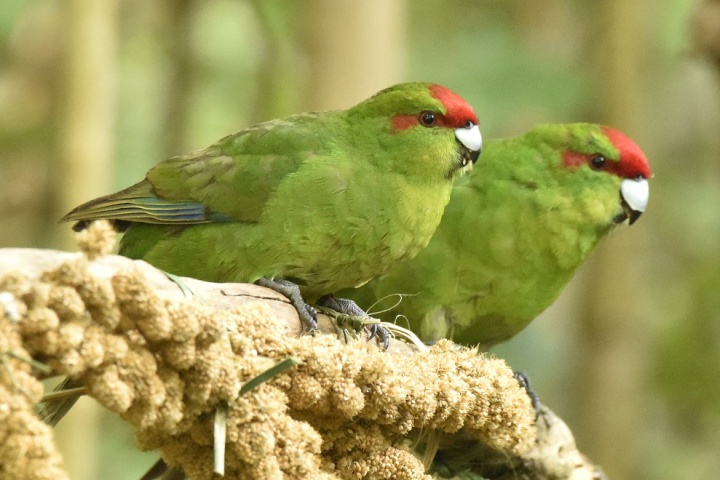Candid Camera Captures Kākāriki
Candid Camera Captures Kākāriki - Video of First
Bay of Islands Wild-Raised Kākāriki in 50
Years
26 February 2018
In what’s thought to be the first time ever, Project Island Song has captured some remarkable video recordings (links below) of the first wild-raised kākāriki chicks in the Bay of Islands in as many as 50 years or more.

Adult kākāriki feeding on millet feeding station – photo by Darren Markin
Some clever technology and a lot of perseverance has produced many hours of groundbreaking footage of young birds not seen in the Bay for more than half a century. They are the offspring of kākāriki, also known as red-crowned parakeets that were reintroduced to the Bay of Islands wildlife sanctuary in June last year. A wide variety of images from strategically placed motion cameras show the recent fledglings learning from their parents and feeding with their siblings. “There could not be prouder parents than the Project Island Song partnership, all our sponsors, donors and hardworking volunteers,” says Project Manager Richard Robbins.
This is thought to be the first time video footage like this has been used to monitor the outcome of a kākāriki reintroduction, and is providing hundreds of hours of highly useful research. It will be important in many ways, confirming the health of the birds, gauging their numbers, but most importantly to better understand the potential genetic viability of the new population as it develops.
The large amount of footage was enabled by another first for the Project, using millet seed feeding stations. They were set up on the island in advance of the birds’ arrival. Though it’s not a natural food source for kākāriki they are very fond of it so it was used to try and encourage the birds to stay on Moturua. This is because they are the first of the Project re-introductions that can move further afield, even fly back to where they were collected from. It’s not expected to be a problem for the young ones however as the parakeets are usually faithful to where they are raised.
The video footage is part of extensive post-release monitoring and has helped confirm the success of the operation to date, with 35 of the 40 birds released being recorded as still on the island, the other five may also still be there but just not using the feeding stations. To help with identification each of the released kākāriki were given a unique leg band colour combination. The video monitoring catalogue is now being analysed to determine any possible family groups of leg banded parents and unbanded offspring, which in turn may help assess the population growth.
“This project is the huge success it is” says Richard, “because of the sustained support we get from our partners: The Guardians of The Bay of Islands, hapū Ngāti Kuta and Patukeha of Te Rawhiti, and the Department of Conservation; and the volunteer monitoring team. Also the generous financial support we received from Explore Group and Forest and Bird, and private donations. And of course all of our Project members and supporters all over the country who are hugely important”.
There are several species of kākāriki all endemic to New Zealand, this one is distinguished by a bright crimson forehead, crown and a streak extending back beyond the eyes. Nesting generally occurs from October through to December, the female incubates 5 - 9 eggs for nearly three weeks and both parents help with the feeding. The male usually regurgitates the food he has consumed and the female passes it on to their chicks. Because this is done on the ground for a period before they can fly this makes them vulnerable to predators, which makes the predator-pest-free islands in the Bay so valuable and so important.
Kākāriki are usually solitary or in pairs,
but form small flocks in autumn and winter. They make a loud
and rapid ki ki ki ki sound when in flight. The
reintroduction of kākāriki is part of the ecological
restoration of the pest free wildlife sanctuaries of
Ipipiri, the eastern Bay of Islands. “They will be an
important addition to the ecosystem, as the way they eat and
digest seeds is believed to be required for some native
plants to germinate,” says Richard.
Background
Project Island Song is a unique partnership between community group The Guardians of the Bay, Te Rawhitit hapū, Patukeha and Ngāti Kuta, and the Department of Conservation. The partnership is dedicated to restoring ecological balance to the islands, drawing together the energy, talent and cultural values of local people to bring the birdsong back to Ipipiri note by note.


 Gordon Campbell: On Fast Track Powers, Media Woes And The Tiktok Ban
Gordon Campbell: On Fast Track Powers, Media Woes And The Tiktok Ban Family First: Just 1 In 6 Oppose ‘Three Strikes’ - Poll
Family First: Just 1 In 6 Oppose ‘Three Strikes’ - Poll Labour Party: Budget Blunder Shows Nicola Willis Could Cut Recovery Funding
Labour Party: Budget Blunder Shows Nicola Willis Could Cut Recovery Funding  Government: Urgent Changes To System Through First RMA Amendment Bill
Government: Urgent Changes To System Through First RMA Amendment Bill Peace Movement Aotearoa: Global Military Spending Increase Threatens Humanity And The Planet
Peace Movement Aotearoa: Global Military Spending Increase Threatens Humanity And The Planet Government: To Introduce Revised Three Strikes Law
Government: To Introduce Revised Three Strikes Law Labour Party: Environmental Protection Vital, Not ‘Onerous’
Labour Party: Environmental Protection Vital, Not ‘Onerous’


